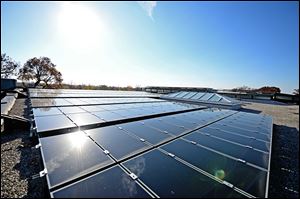
GUEST COLUMN
To see solar energy’s future, look to the past
Solar industry businesses are using targeted strategies not to develop solar technology, but to deploy it
1/19/2014
Colm

Colm
It's all too easy to dismiss Ohio’s solar energy industry as an overfunded passing fancy — a short-term, fly-by-night sham. Since 2008, state government has given tax breaks, grants, and loans to a host of solar entrepreneurs and businesses, only to watch many of them fail to produce the jobs, sales, or potential they projected.
For perspective, let’s go back to the early 1900s: America’s budding auto industry attracted scores of inventors, developers, and manufacturers, all vying for a piece of an emerging market. Hundreds of businesses sprang up around the country, rolling out new technology and innovative designs to capture the attention and imagination of a huge mass market that saw the potential in horseless transportation.
Through natural attrition, most of these early entrepreneurs eventually shut their doors, for reasons ranging from bankruptcy or mergers to technical obsolescence and phaseouts. Entire technologies, such as steamers and early electric autos, vanished. But that didn’t mean cars were a bad bet for the future. Early consumers didn’t revert to horse-and-buggy transport because some companies failed.
In 2014, a similar picture of the solar energy industry emerges. A burgeoning industry is racing to advance a variety of fast-developing technologies, all designed to create products that generate clean, efficient power and are simpler to produce and easier to afford. That’s what a huge mass market that envisions cheap, reliable, clean domestic energy demands.
The barriers to market success in solar energy are different from those that automotive pioneers faced. U.S. solar manufacturers are battling constraints that have contributed to corporate attrition, in addition to technology challenges.

Solar panels on the roof of Toledo Museum of Art lighten the building’s draw on the power grid. Solar power is attracting the attention of public buildings and businesses around the country.
In 2008, when Ohio manufacturers were gearing up to mass-produce solar power systems, no one foresaw the collapse of the U.S. economy. Start-up solar manufacturers were hit just as hard as other businesses. The recession led to staff reductions, a sharp drop in market demand, and eventually, closed doors.
At the same time, Chinese producers caused a seismic change in the marketplace that no one predicted. Highly subsidized Chinese solar panel manufacturers, whose overcapacity forced them to dump their panels in the United States and elsewhere, disrupted domestic production. They fueled demands by U.S. manufacturers that lawmakers enact policies to level the playing field and stimulate competition.
U.S. policy makers responded with public dollars, because they realized the potential for solar energy and foresaw the marketplace demand for solar products. These public funds were intended to encourage development of new technology that would make commercial mass production of solar panels easier. The high-risk product development cycle tends to swallow up dollars rapidly.
Since then, there has been a natural shakeout in the solar sector. The remaining businesses in the industry are using targeted strategies not to develop technology, but to deploy it. Manufacturers don’t need as many resources to figure out the next generation of solar panels. They are fervently trying to beat pricing challenges.
The market for solar energy has never been better. According to the Solar Energy Industries Association, prices of solar panels have fallen by 60 percent since 2011. The average price of an installed solar project has dropped by 30 percent.
Solar power, like other renewable-energy sources, is attracting the attention of bellwether businesses around the country. Google, Bank of America, Merrill Lynch, and other companies are investing billions of dollars in financing solar energy installations nationwide.
Wal-Mart is the largest corporate consumer of solar energy, with a reported 89 megawatts of capacity derived from its own rooftops. That’s enough electricity to power 22,250 U.S. homes.
The residential solar market continues to grow rapidly as well. Through the third quarter of last year, residential solar installations were up 45 percent over the same period of 2012, driven largely by increasingly attractive economics, federal tax credits, and growing market demand for renewable energy.
U.S. homes and businesses had enough solar panels in mid-2013 to produce 5.1 gigawatts of electricity, up 46 percent from a year earlier.
Clearly, solar energy is not going away.
It’s important that Ohio keeps investing in the industry’s future — and that Ohioans focus more on the potential of this rich energy source, and less on which particular businesses will prevail.
John Colm is president and executive director of WIRE-Net, a Cleveland-based nonprofit economic development organization.